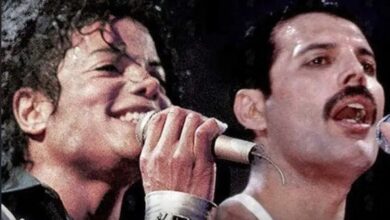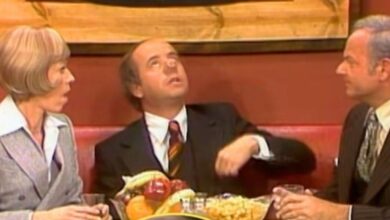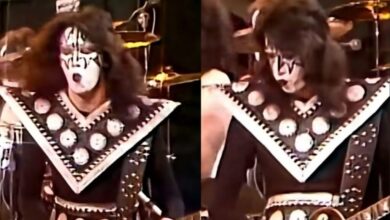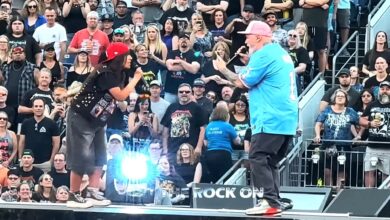When Metal Collided with Pop: Lady Gaga and Metallica’s Explosive Grammy Fusion
Some performances simply light up a crowd, others linger in memory, but only a few redefine what live music can be. At the 59th Annual Grammy Awards, one such moment unfolded—a breathtaking collision of heavy metal and pop spectacle that few anticipated but none could forget. In 2017, the Staples Center transformed into a roaring temple of sound as Metallica’s James Hetfield and pop visionary Lady Gaga took the stage together for a ferocious rendition of “Moth Into Flame.” The air was electric, the tension palpable, and what followed would go down as one of the boldest performances in Grammy history.
Before the curtain rose, many questioned whether this unexpected collaboration could work. Metallica, the embodiment of metal’s raw aggression, and Lady Gaga, the reigning force of theatrical pop, seemed worlds apart. Yet when the lights dimmed and the first chords echoed, the skepticism dissolved instantly. This was not a clash—it was a communion of two energies that fed off each other, proving that passion for performance transcends genre and expectation.
As the first riffs thundered, Gaga stormed the stage in black leather and glittering spikes, exuding fearless confidence. Her movements carried the same defiant power that had long defined Metallica’s music. Across from her, Hetfield commanded the room with his trademark growl and the authority of a seasoned warrior. Every glare, every chord, every step spoke of unity rather than difference, and within moments, the crowd became a single pulsating force responding to their shared rhythm.
Just as the chemistry reached its peak, the unexpected struck—Hetfield’s microphone went silent. His voice, a signature of metal’s history, was lost in the live broadcast. Millions at home were momentarily cut off from his roar. But in that split second, Gaga reacted instinctively. She turned, offered her mic, and without missing a beat, they sang together, their voices intertwining in perfect defiance. The mishap turned into magic—a symbol of resilience, spontaneity, and unshakable showmanship.
Instead of ruining the performance, the glitch only heightened the intensity. Gaga’s powerhouse vocals filled the void, soaring above the wall of guitars and drums. She matched Metallica’s fury note for note, her delivery bursting with raw power and conviction. She didn’t just adapt—she transformed, showing that her artistry carried the same edge and authenticity that fuels the heart of metal. Her command of the stage blurred any line between pop and rock, uniting both under pure adrenaline.
Hetfield, visibly angered for a fleeting moment, channeled his frustration into unrestrained ferocity. Each strum of his guitar seemed sharper, every movement more primal. When his microphone finally returned, his voice roared even stronger than before, infused with pure determination. The setback lit a fire in him, and the audience responded in kind, erupting in applause as the two forces at center stage turned potential failure into triumph through sheer passion and power.
The stage became a whirlwind of light and sound. Flames burst upward as Lars Ulrich’s drums pounded like thunder, shaking the arena’s foundation. Kirk Hammett tore through his solo with blistering precision, each note sparking energy through the crowd. Amid the chaos, Gaga danced like she belonged there all along, a fusion of glam and grit, her confidence radiating with every move. She wasn’t borrowing space in metal—she was earning it.
When the final notes rang out, the audience erupted into thunderous applause. Critics and fans alike recognized that this was more than a performance—it was a declaration. It shattered old assumptions, tore down invisible walls, and proved that true artistry thrives in risk. Metalheads applauded Gaga’s courage, while her fans discovered the unrelenting power of Metallica’s legacy. It was the kind of musical union that felt both unpredictable and inevitable once it happened.
In the days that followed, both Hetfield and Gaga spoke candidly about the mishap, expressing frustration but also pride. What could have been remembered as a technical failure instead became an example of professionalism and grace under pressure. Their ability to adapt so seamlessly became part of the legend, a testament to what happens when experience and instinct collide on stage. The mistake turned into the heartbeat of the story—a symbol of art’s unpredictability.
Online, the moment spread like wildfire. Photos of Gaga and Hetfield sharing a microphone filled timelines across the globe. Memes, remixes, and reaction videos flooded social platforms. Fans debated the collaboration’s meaning, but the overwhelming sentiment was admiration. People marveled at the chemistry, the boldness, the refusal to give up. The live video amassed millions of views within days, securing its place among the most talked-about Grammy performances of all time.
Lady Gaga would later describe the night as one of her career’s most exhilarating experiences. She spoke about her deep respect for Metallica and how the collaboration reaffirmed her belief in the power of performance without boundaries. For her, it wasn’t just a genre crossover—it was a statement of artistic unity. She had always pushed creative limits, but this time, she did it in front of an audience that demanded nothing less than authenticity.
For Metallica, the night stood as a daring reminder that evolution is part of endurance. By performing with one of pop’s biggest icons, they introduced their music to a new generation. Young fans who had never heard “Master of Puppets” or “Enter Sandman” suddenly found themselves exploring Metallica’s catalogue, drawn in by the band’s raw magnetism. It was an expansion not of sound, but of spirit—a reaffirmation that their reach had no limit.
Even years later, the Grammy collaboration remains a reference point whenever boundaries between genres are challenged. It’s remembered not just for the flames, lights, and technical hiccups, but for the courage and authenticity that defined it. Every great live moment carries a pulse of risk, and this one proved how chaos can give birth to something unforgettable. It was the ultimate reminder that imperfection often amplifies greatness rather than diminishes it.
In its aftermath, the message resonated far beyond the stage: when two worlds collide with sincerity and passion, music wins. That night, as Gaga and Metallica defied expectations, the audience witnessed more than a duet—they witnessed the raw electricity of creation itself. It wasn’t pop meeting metal; it was humanity meeting expression, and from that union came something both chaotic and transcendent, destined to echo through the years as a testament to live music’s unstoppable force.





